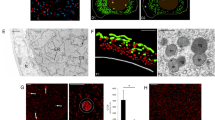Abstract.
Oocytes of certain insects contain peculiar organelles termed accessory nuclei (AN). These organelles originate by budding off from the envelope of the oocyte nucleus and contain 1–2 dense inclusions immersed in a translucent ground substance. We have demonstrated that in the wasp Vespula germanica each inclusion consists of two elements: a spherical body, and a hemispherical structure composed of numerous 20–30 nm particles. Immunoelectron microscopy and whole-mount in situ hybridization have shown that the inclusions contain AgNOR-staining proteins, p80-coilin, Sm proteins, and small nuclear RNAs (snRNAs). These results indicate that the inclusions and hemispherical structures are homologous to Cajal bodies and B-snurposomes of Xenopus germinal vesicles, respectively. During previtellogenesis, AN (together with their Cajal bodies) migrate to the cortical ooplasm of the oocyte where they reside at least until the onset of embryogenesis. We suggest that AN are vehicles for the transport and localization of snRNPs to the periphery of the oocyte, i.e., to the region where the blastoderm of the embryo develops and where there is a requirement for a high concentration of RNA-processing factors.
Similar content being viewed by others
Author information
Authors and Affiliations
Additional information
Electronic Publication
Rights and permissions
About this article
Cite this article
Biliński, S.M., Kloc, M. Accessory nuclei revisited: the translocation of snRNPs from the germinal vesicle to the periphery of the future embryo. Chromosoma 111, 62–68 (2002). https://doi.org/10.1007/s00412-002-0186-4
Received:
Revised:
Accepted:
Issue Date:
DOI: https://doi.org/10.1007/s00412-002-0186-4




